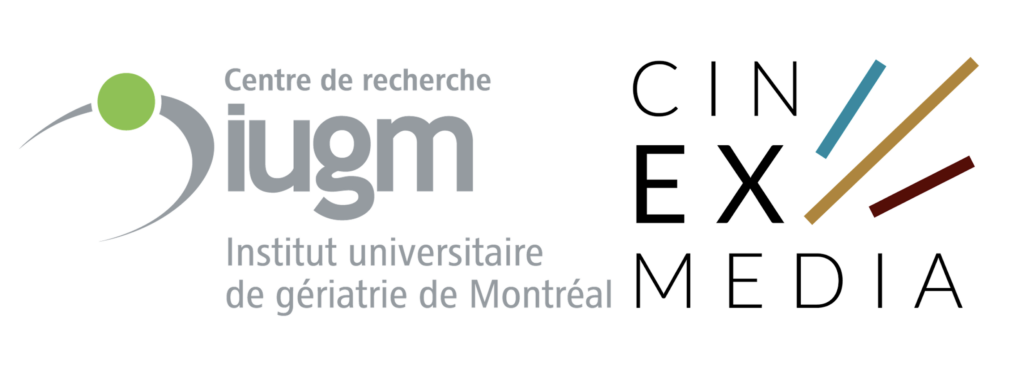The two organizations are working together on a variety of intersectoral projects related to geriatrics.

Hugo Samson
The cinEXmedia partnership joined forces with the Centre de recherche de l’Institut universitaire de gériatrie de Montréal (CRIUGM) in 2022 to carry out a variety of intersectoral projects combining cinema studies and the health sciences. As these projects begin to take shape, we are introducing them in more detail in this new series of texts being launched to highlight this collaboration.
Barbara Delacourt, a doctoral student at the l’École d’orthophonie et d’audiologie at the Université de Montréal and a researcher at CRIUGM, explains that the Centre “works on every aspect of geriatrics, whether on the level of mental health, nutrition, sleep or physical activity”.
The organization has thirty-nine active researchers, nineteen associate researchers, nearly thirty post-doctoral interns and more than 200 graduate students. All told, more than 300 people work there to advance research in the field of ageing and to contribute to knowledge transfer.
The Neuroscience of Ageing
Ana Inés Ansaldo, a full professor at the Université de Montréal and director of teaching at the Institut universitaire de gériatrie de Montréal (IUGM — in French only) describes the research centre as having been founded by researchers whose objective was to study communication disorders amongst people with neurological illnesses.
“Since CRIUGM was founded, the themes of communication and language have been a part of its DNA”, she explains. “In its more than forty years of existence, the Centre has explored several topics always with the goal of better understanding the connections between neurological mechanisms and communication”.
“Being associated with a hospital [in this case the UGM] enables us to connect research and clinical practice”, Barbara Delacourt adds.
Shining a Light on Dementia
In particular, the cinEXmedia-CRIUGM partnership has given rise to the Lumière project. “The goal is to create a catalogue of therapeutic audiovisual clips which will be adapted to being viewed by people with dementia and their caregivers”, explains Ansaldo, who heads up the project, whose team members include researchers in speech therapy, cinema and artificial intelligence.
She emphasizes that “this is a means for countering the isolation that dementia naturally produces”. For her it is also a question of using an unconventional and innovative approach in the care of these vulnerable patients.
The “therapeutic aspect” of the research carried out by cinEXmedia and CRIUGM is, moreover, what unites the two organizations, explains Alice Guilbert, a master’s student in cinema studies at the Université de Montréal, whose work is supervised by Santiago Hidalgo, executive director of Laboratoire CinéMédias.
Laboratory Experiments
We should point out that it is the reactions of participants with dementia when watching audiovisual materials shown to them in a laboratory which make it possible to establish a catalogue of therapeutic clips whose production is the goal of the project.
At this stage of the experiments, the materials are quite varied, including for example promotional tourist videos and clips from fiction films. “We are trying to see what the cinematic parameters are which act on people living with dementia”, Alice Guilbert explains.
In addition, the Lumière project team has created a system for filming participants’ reactions. Video cameras film them in pairs in order to capture their body language as well as their facial expressions, while wrist bands record their cardiac data.
“In the pure sciences, it is very important to consider the environment in which experiments are carried out”, Guilbert notes. “We have called on researchers in cinema for their ability to identify what parts of the videos can have an effect on the results, particularly in order to create positive emotions, as much as for their knowledge of cinema”.
Intersectoral Research
Intersectoral Research has been at the heart of the cinEXmedia-CRIUGM collaboration since its beginnings. Ana Inés Ansaldo explains that the idea of the partnership came to her when she was attending the second intersectoral encounters on rhythm, co-organized by Laboratoire CinéMédias and the Vice-rectorat à la recherche, à la découverte, à la création et à l’innovation at the Université de Montréal in December 2019.
“When we speak of communication we often think of language, but before spoken language people were able to communicate through art, through painting”, Ansaldo remarks. It was precisely by attending a lecture on the emotional impact of rhythm in cinema that she wanted to use the medium “as a kind of catalyst for intentional communication”.
Incorporating media research into the medical sciences for therapeutic purposes is a relatively new development, but this practice has the potential to open up unexpected perspectives.
“It is especially interesting that there had not been any research into ageing and the cinema until now, either with persons in good health or with people with pathologies such as neurocognitive disorders”, Barbara Delacourt points out.
Barbara Delacourt’s doctoral research will be the topic of our next text in this new series on CRIUGM. Other articles and interviews will appear in the coming months.
